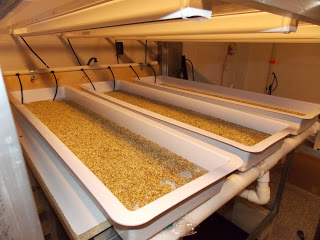
feed for livestock with minimal input: hydroponic fodder. Hydroponic fodder production is simply that,
growing livestock feed (barley, oats, clover, alfalfa etc.) hydroponically. Generally speaking, production time of
hydroponic fodder is rapid. Barley for
example can be ready to harvest in as little as 7 days! A
grower can expect approximately seven pounds of fodder for every one pound of barley seed. Possible additional benefits of hydroponic fodder include higher meat and milk production and better heat cycles. So,
the Hort Americas Research Division set out to grow barley seed under LEDs in a
recirculating hydroponic system. Johnny’s Selected Seeds has a wide selection
of seed. Johnny’s has organic barley
seed available in a variety of bag sizes. We
selected two, 5 lb bags for just under $9.75 per bag. Fifty pound bags are also available. There are other bulk seed suppliers and we will continue to compare product and pricing.
 |
| Barley seed in propagation trays. |
Upon receipt, the seed was poured into the propagation trays
at a depth of approximately 1/2”. The
drainage holes were plugged and the seed was submerged in water for 24 hr. After 24 hr. the water was drained
from the trays and discarded. After
draining the water, a half-strength nutrient solution was prepared using Kimitec
brand fertilizer (see below). Lighting was initiated
at Day 1 using GreenPower LED Deep Red / Blue 120 Production Modules (DRB 120). The DRB 120s were placed over the center of
each tray at 12” above the table. A Li-Cor
quantum sensor and meter (LI-205A) was used to measure instantaneous light
intensity. Light intensity was
approximately 70 µmol·m-2·s-1
and photoperiod was 18 hr. This produced
a DLI of approximately 4 to 5 mol·d-1. To maintain adequate moisture and provide nutrition,
the seeds were irrigated every two hours for 5 minutes. Radicles were visible at Day 1. After two days root formation was
obvious. At Day 3 coleoptiles began to
form and a full strength nutrient
solution was applied to the plants. By Day 4, the coleoptiles appeared to double
in length and the first leaves were visible. At Day
5, leaves continued to grow and the root mat was well developed. Plants appeared to be ready by Day 6, but we decided to continue growing the barley
for 7 full days before harvesting. On Day
8 the fodder was harvested and delivered to a local goat farm within 40
minutes. We want to thank Katherine of Harrison Farm for expressing interest in this trial and for allowing us to bring the fodder to her goats.
So in summary:
- Day 0:
- Seed poured directly into hydroponic
propagation trays at a depth of ½”. - Seed soaked in water for 24 hr.
- Day 1:
- Drained/discarded the water from the trays
after 24 hr. - Began irrigating with a half-strength
nutrient solution every 2 hours for 5 minutes: - 2 ml of Espartan per gallon of water
- 2 ml of Amifort per gallon of water
- 6 ml of Caos per gallon of water
- 3 ml of Tundamix per gallon of water
- 0.5 tsp of MgSO4 per
gallon - Lighting provided to seeds via DRB 120s
- One DRB 120 was placed 12”
above the center of each propagation tray (three total). - Light intensity was
approximately 70 µmol·m-2·s-1. - Photoperiod was 18 hr.
- DLI was between approximately 4 to 5 mol·d-1.
- Energy consumption per DRB 120 is 35 Watts
- Daily energy consumption = 1.89 kW per day
- Total energy consumption (7 days) = 12.23 kW
- Local electrical rate = $0.08 USD per kWh
- Daily lighting cost = $0.15 USD per day
- Day 2:
- Continued irrigation and lighting protocol
- Day 3:
- Nutrient solution was increased to
full strength: - 4 ml of Espartan per gallon of water
- 6 ml of Bombardier per gallon of water
- 13 ml of Caos per gallon of water
- 6 ml of Tundamix per gallon of water
- 1 tsp of MgSO4 per
gallon - Day 4 through 7:
- Continued irrigation and lighting protocol
- Day 8:
- The fodder was harvested and delivered to a local
livestock farmer within 40 minutes.
NOTE: Nutrient regimen was a trial. Basically, we used recommended Kimitec fertilizer rates per gallon for coco slab growing and applied it via a completely soilless, recirculating system. We will continue to adjust the nutrition and should we conduct tissue analysis, we will post the results. We have selected to postpone the discussion comparing the cost per ton of hydroponic fodder versus cost per ton of hay/grain. To be continued…
 |
| Day 1 – radicle emergence |
 |
| Day 2 – root formation |
 |
| Day 3 – coleoptile formation |
 |
| Day 4 – coleoptile and first leaf formation |
 |
| Day 4 – coleoptile and first leaf formation |
 |
| Day 4 – barley under LEDs |
 |
| Day 5 – root formation |
 |
| Day 6 – first leaf well developed |
 |
| Day 7 – ready to harvest |
Visit our corporate website at https://hortamericas.com



